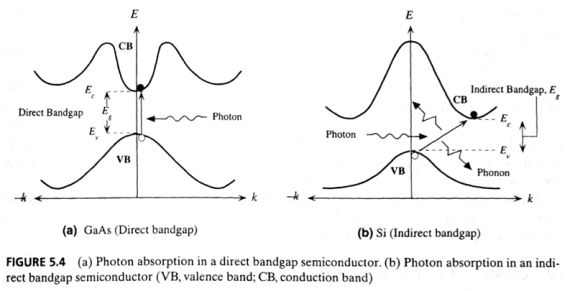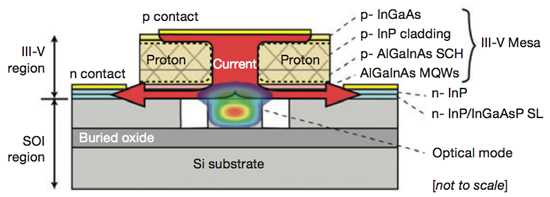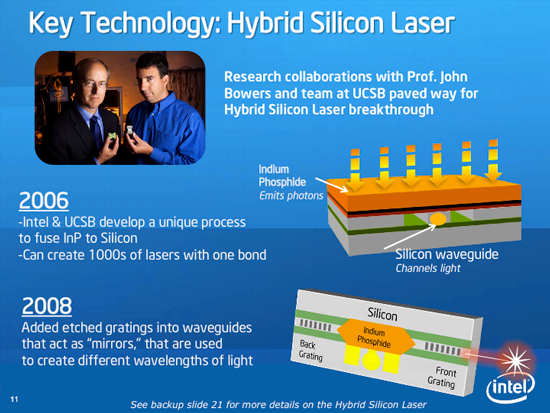Intel's 50Gbps Silicon Photonics Link: The Future of Interfaces
by Brian Klug on July 30, 2010 6:49 AM EST- Posted in
- Trade Shows
- Intel
- Photonics
- Laser
It's all about Silicon
I mentioned material constraints before - without getting into too much detail, let’s talk about what makes a laser work. For every laser, you need a few things: gain medium (which should spontaneously emit photons in the presence of other photons, effectively adding optical gain), an optical resonator or feedback (in its simplest form, a cavity with mirrors at both ends), and some way of pumping (providing energy to, either electrically, optically, or whatever works for the material) the gain medium.
The problem with silicon has been that it traditionally hasn’t lent itself to creating light very well at all - it has what’s called an indirect bandgap. When electrons fall from one energy state to the other, instead of the material emitting a photon (which is what happens in a direct bandgap material), it emits primarily phonons (lattice vibrations - and through a ton of hand waving and thermodynamic processes, heat), and very few photons. In order for a material to emit large quantities photons when electrically pumped, it should have a direct bandgap.

Indirect vs Direct bandgap - from Optoelectronics and Photonics: Principles and Practices by S. O. Kasap
The result for the longest time was that making a silicon laser seemed fundamentally impractical - how can something which doesn’t want to emit light be a good gain material at all?
Silicon has advantages, however. For example, silicon oxide makes an almost ideal cladding material (surrounding normal silicon). Think - fiber optic cable, but as traces embedded in your motherboard, all manufactured using traditional CMOS processes available now.
What’s new about Intel’s design - by John Bowers’ group at UCSB and a number of other researchers - is that the laser is hybrid silicon. Other previous designs have used other gain media with direct bandgaps more suitable for spontaneous emission, but with other bigger design challenges. One problem with these other materials that the crystal lattice may be too different from the silicon substrate underneath it - the result is what’s called lattice mismatch and it results in undesired optoelectronic properties. To some extent, lattice mismatch can be mitigated with an epitaxial (imagine an intermediary layer between the two mismatched material). Another problem is that thermal expansion of the materials (silicon, and whatever other material is being used for the laser) is often different as well, making it hard to physically keep things together and creating a host of other challenges. There’s also the issue of aligning the system. Previous designs have worked, at the expense of being more difficult to fabricate, and thus more expensive.

Intel’s design uses indium phosphide (InP) and aluminum gallium indium arsenide (AlGaInAs) layers, all of which can be deposited at wafer scale. The result is that there’s no discrete laser assembly or alignment. Wavelength selection and feedback are done with a distributed feedback bragg grating, which is relatively conventional. The combination of materials and manufacturing processes in this design by Intel yields itself to mass production without caveats. The end result is a hybrid silicon laser that's relatively easy to manufacture in large quantities using traditional processes.

As for the detector - bias a similar stack of components the other way, and you’re done.
Combined with Intel’s work on photonic integrated circuits on silicon for the modulator, waveguide, multiplexer and demultiplexer (for WDM), and you can see how the building blocks necessary for building optical interconnects came together.










42 Comments
View All Comments
GullLars - Wednesday, August 4, 2010 - link
Go liquid cooling, and you can get 500-2000W worth of power as densely packed as an ITX card. By using optical connections to build in 3D, you can have multiple planes of components.nafhan - Friday, July 30, 2010 - link
Another problem with motherboard design that this will help with is RF interferance.nafhan - Friday, July 30, 2010 - link
For anyone with a radio background, if the term WDM seems odd it's the term used by fiber optic people for FDM.Also, like to emphasize how big of an advantage that photonics/fiber optics have over normal electrical signals in motherboard design or any other application with a high frequency electrical signal. Replacing electrical signals with something that has essentially no radiated signal is huge. No interference is a very good thing.
This stuff is just cool...
spunlex - Friday, July 30, 2010 - link
<quote> it emits primarily phonons (lattice vibrations - and through a ton of hand waving and thermodynamic processes, heat), and very few electrons. </quote>I think this should read "and very few <b>photons</b>."
Great article, it's good to see manufacturing of cheap quality lazers really took of in the past couple year. I am looking forward to many more interesting articles on photonics.
spunlex - Friday, July 30, 2010 - link
I totally forgot these comments don't support formating, still pining for the edit feature.Brian Klug - Friday, July 30, 2010 - link
Oh wow good catch! That's what I get for writing this so late at night!-Brian
spunlex - Friday, July 30, 2010 - link
I know what you mean, no where near as bad as some of the late night lab reports I have handed in.iwodo - Friday, July 30, 2010 - link
It mean we finally have VERY Good On broad Audio Chipset,GDILord - Monday, August 2, 2010 - link
Well, what exactly do broads have right now? :-)cesthree - Saturday, July 31, 2010 - link
When can we get this for an external GPU case?Have a case that only houses GPU's with their own PSU's and cooling solutions.
Connect that case with your case via a Photon Link. I can't begin to list the advantages of a setup like this.
I'm sure there is disadvantages. I know I would buy/make one if I could.